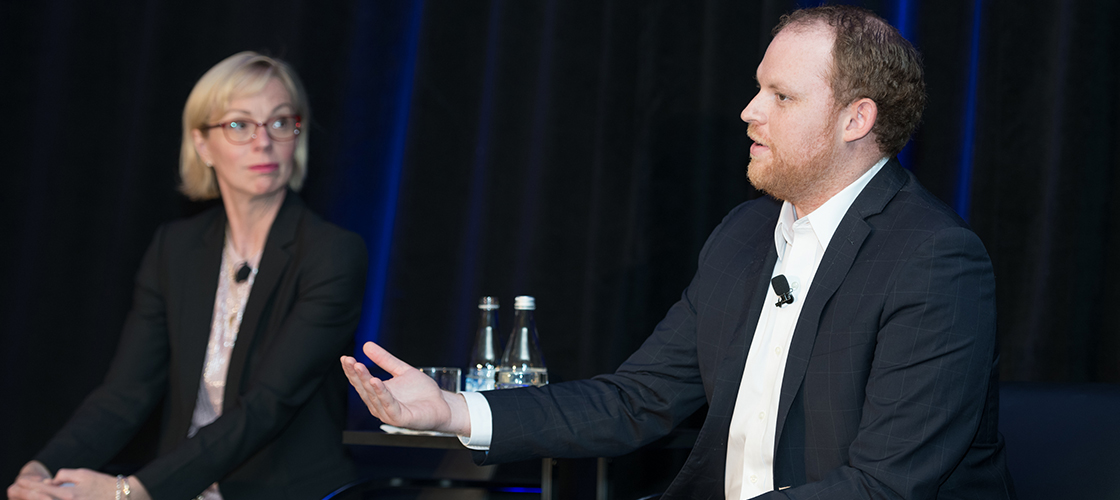
Fidelity’s Michelle Munro and Andrew Clee discussed emerging trends in retirement and in ETFs at the ETF Summit 2019 in October.
There was a time when retirement planning seemed simpler – for advisors and for their clients.
By and large, clients retired debt-free, and many could rely on defined benefit pension plans to provide them with a steady stream of income. Now more Canadians retire with debt and must depend on market-exposed investments to generate sufficient money to cover their living expenses. Meanwhile, advisors must create highly individualized plans to achieve each client’s retirement lifestyle goals.
The good news, said Fidelity’s Michelle Munro and Andrew Clee at the ETF Summit 2019 on Oct. 1, is that ETFs are evolving to meet clients’ different needs approaching and in retirement, and are no longer a one-size-fits-all solution.
Munro, director of tax and retirement research, set the scene by highlighting key findings from the 2019 Fidelity Retirement Survey she co-authored. The survey asked retirees how they spend the extra time they have in retirement. They replied that they were spending more time than expected online, with family and friends and pursuing hobbies, and less time than expected on arts and entertainment, travel and sports and fitness – which may, of course, have repercussions on their spending.
“Then we took this one step further because retirement really lasts a long time. There’s a gentleman by the name of Michael K. Stein—he’s a retirement author in the U.S.—and he tried to segregate that long duration of retirement into three phases: the go-go years, the slow-go years and the no-go years,” she said. “We took those, and we looked at how retirement activities were going to change during those three phases.”
“Ask the question ‘do you have debt?’ so you have the whole financial picture of what retirees are facing.”
- MICHELLE MUNRO, DIRECTOR OF TAX AND RETIREMENT RESEARCH AT FIDELITY
During the go-go years, travel and social media dominated. In the slow-go years, spending time with family and friends and sports came to the forefront. As people started to face more health challenges, there was more online activity and volunteering.
Munro pointed out that client preferences play a large role in determining costs in each phase. That’s why Munro said it’s so critical for advisors to help clients define, as precisely as possible, their vision for retirement. In the five years before retirement, she said, it’s vital for advisors to help clients determine their retirement goals, estimate expenses, identify sources of income, reduce or eliminate debt and top up savings. Then, in the five years after retirement, the focus shifts to following a retirement budget, monitoring withdrawals from savings, reviewing finances annually and finding a social structure.
“We all spend eight-plus hours a day at work, and typically for retirees – especially early retirees – it’s a challenge to fill those eight hours,” she said. “What comes with that is, they end up spending more money than they anticipated. But you can help them keep their long-term retirement plans on budget.”
Working and debt in retirement
A very interesting finding from the 2019 Fidelity Retirement Survey is that 70% of pre-retirees believe they’ll be working in retirement. This compares to just 34% of retirees who are actually working, but Munro believes that number will rise as pre-retirees move into retirement.
That said, the top reason for working in retirement isn’t to earn a paycheque. Instead, many retirees say they work to stay mentally and/or physically active, to stay busy or help pass the time, to gain a sense of purpose and for social reasons. Even among those who say they are working for financial reasons, it’s not necessarily to make ends meet.
“It really was reasons to enjoy life, to thrive,” said Munro, explaining that, for many, the extra income simply meant an additional or fancier vacation, or an additional or fancier dinner out every week. “There is a smaller segment who are working in retirement because they need to, because they haven’t saved enough, and that’s a reality for some, but working with an advisor … helps them to minimize or alleviate some of that stress.”
Another important area the survey explored was debt among retirees. “Canada has one of the highest household debt per GDP in the world, which I thought was really outstanding, so we wanted to understand, what does that mean for retirees?” Munro explained.
It turned out that 42% of retirees had some long-term debt when they began their retirement, and 31% of those with long-term debt incurred more debt during their retirement. Reasons included higher spending in the early years of retirement, assisting aging parents with healthcare challenges and helping adult children get established, Munro said. For advisors, the key takeaway is not to assume retired clients have no debt.
Speaking to the value of advice, Munro pointed out that retirees with an advisor and a written plan were less likely to have experienced an increase in debt within the past few years. “That really highlights the importance of having a written financial plan and working with she said.
For advisors, creating written financial plans that encompass financial, emotional, social and health components and that accommodate varying levels of expenses in early, middle and later retirement is key to preparing clients for shifting retirement realities, according to Munro.
A little ETF exposure can go a long way
“Let’s take a walk through time on the ETF industry,” suggested Clee, vice-president of ETFs, as he took the stage. A decade ago, when Clee started covering the industry as a research analyst, 95% of ETFs passively tracked benchmarks like the S&P 500, S&P TSX or Canada Universe Bond Index. “The common theme was, everything had a beta of 1.0. So if the market’s up 10%, the ETF is up 10%. If the market’s down 10%, the ETF is down 10% as well,” he recalled.
Value of advice
| RETIREES | PRE-RETIREES | |||
|---|---|---|---|---|
| WITH a plan | WITHOUT a plan | WITH a plan | WITHOUT a plan | |
| Financially | 96% | 70% | 88% | 43% |
| Emotionally | 90% | 81% | 79% | 64% |
| Socially | 89% | 78% | 84% | 67% |
| Physically | 91% | 77% | 89% | 67% |
| Source: 2019 Fidelity Retirement Survey | ||||
Today, quantitative ETFs (also known as smart beta, factor or style ETFs) represent about 20% of equity ETF market share. They include strategies such as dividend yield, low volatility, high quality, momentum and value, require a little more due diligence and come at a slightly higher price point. Meanwhile, more and more active ETFs are emerging as traditional mutual fund managers launch ETF versions of actively managed solutions. “It’s just a wrapper to deliver that investment expertise,” he said.
But perhaps the biggest change in the ETF industry, Clee suggested, is using these types of products to implement goals-based investing. Clee focused his presentation on three applications of quantitative ETFs suggested by responses to a Fidelity poll of U.S. institutional investors and family offices that asked how they were actually using ETFs in portfolios.
“ETFs are great for client customization, and very small changes in a portfolio can help address goals-based investing.”
- ANDREW CLEE, VICE-PRESIDENT OF ETFS AT FIDELITY
First, ETFs can help achieve strategic exposure in a long-term retirement portfolio because, as Clee pointed out, “all factors have the ability to outperform broad indices in the long run.” Meanwhile, combining factors with low correlations – say, value and momentum – can improve performance during periods when one factor lags. “By putting two together, you take advantage of that long-term return and still take out some of the ride in the short term.”
5 essential
retirement strategies
“We have more seniors than ever, and the path to retirement is more complicated than ever. It really highlights the importance of what you’re doing to prepare your clients for retirement,” said Munro.
Become an expert in each of these areas and your clients will thank you, she added:
- Create a vision
- Manage the retirement transition
- Create a retirement paycheque
- Be aware of retirement trends
- Develop a written financial plan
Second, even a small allocation can enhance portfolio construction, he offered, sharing a simulation that adjusted a six mutual fund portfolio for a retiree requiring emphasized, “very small changes can have a dramatic impact on your client’s experience.”
Third, ETFs can assist with cyclical exposure designed to enable clients to benefit from styles that tend to do well during specific stages of the business cycle. In part, that’s because of their resistance to style drift. “They’re rules-based and they’re transparent. They rebalance annually, semiannually, quarterly – depends on which manufacturer you buy. But ETFs do not get exposed to style drift. The reason for that is there are no emotions that come into this,” he stated.
ETFs’ lower price point is also attractive when creating income-generating portfolios for clients in retirement, he added.
“We’re not believers that you should be 100% active, 100% quantitative or 100% passive,” Clee concluded. Rather, he emphasized, “ETFs are great for client customization, and very small changes in a portfolio can help address goals-based investing. That helps get clients to their retirement goals without taking on undue risk.”
BROUGHT TO YOU BY

